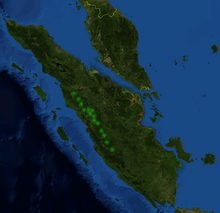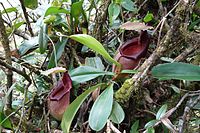Nepenthes bongso
| Nepenthes bongso | |
|---|---|

| |
| A freshly opened lower pitcher | |

| |
| An upper pitcher of a variant sometimes distinguished as N. carunculata, from a minor peak near Solok, West Sumatra | |
| Scientific classification | |
| Kingdom: | Plantae |
| Clade: | Tracheophytes |
| Clade: | Angiosperms |
| Clade: | Eudicots |
| Order: | Caryophyllales |
| Family: | Nepenthaceae |
| Genus: | Nepenthes |
| Species: | N. bongso |
| Binomial name | |
| Nepenthes bongso | |

| |
| Distribution of N. bongso | |
| Synonyms | |
| |
Nepenthes bongso /nɪˈpɛnθiːz ˈbɒŋsoʊ/ is a tropical pitcher plant endemic to Sumatra, where it has an altitudinal distribution of 1000–2700 m above sea level.[10][11] The specific epithet bongso refers to the Indonesian legend of Putri Bungsu (literally "youngest daughter"), the spirit guardian of Mount Marapi.[10]
The species was formally described by Pieter Willem Korthals in his 1839 monograph, "Over het geslacht Nepenthes".[2]
Nepenthes carunculata[note a] is considered a heterotypic synonym of N. bongso by most authorities.[8][9][10][12] The infraspecific taxon Nepenthes carunculata var. robusta was described in 1994 by Joachim Nerz and Andreas Wistuba.[13] It is an extreme variety of this taxon with a large, flared peristome.[13]
In his Carnivorous Plant Database, taxonomist Jan Schlauer treats N. junghuhnii (sensu Macfarlane) as a possible synonym of N. bongso.[14]
Related species
| Character | N. bongso | N. dubia | N. talangensis | N. tenuis |
|---|---|---|---|---|
| Shape of upper pitchers | tubulate - infundibulate | tubulous in the lower part, infundibulate above the middle | tubulous to narrow infundibuliform in the lower half, ovate in the upper half | wide infundibulate, contracted below the mouth |
| Lid | orbiculate | narrow cuneate | broad-ovate | very narrow elliptical |
| Length/width ratio of upper pitchers | 3.3 | 1.9 | 2.3 | 1.75 |
- A typical lower pitcher of N. bongso
- Lower pitchers (developing, open, and dried)
- Lower pitchers of N. carunculata, which is often treated as a synonym
Natural hybrids
The following natural hybrids involving N. bongso have been recorded.
- N. bongso × N. gymnamphora[10]
- N. bongso × N. singalana[10]
- N. bongso × N. talangensis[10]
In his 1928 monograph "The Nepenthaceae of the Netherlands Indies", B. H. Danser mentioned what he thought was the hybrid N. bongso × N. pectinata;[5] however, this plant material is now known to represent N. densiflora,[10] a species described by Danser 12 years later.[15]
Notes
- a.^ Nepenthes carunculata is pronounced /nɪˈpɛnθiːz kəˌrʌŋkjʊˈlɑːtə/. The specific epithet is derived from the Latin word caruncula, a diminutive of caro (flesh), and refers to the fleshy seed appendages of this taxon.
References
- ^ Clarke, C.M. (2018). "Nepenthes bongso". IUCN Red List of Threatened Species. 2018: e.T39625A143957450. doi:10.2305/IUCN.UK.2018-1.RLTS.T39625A143957450.en. Retrieved 19 November 2021.
- ^ a b (in Dutch) Korthals, P.W. 1839. Over het geslacht Nepenthes. In: C.J. Temminck 1839–1842. Verhandelingen over de Natuurlijke Geschiedenis der Nederlandsche overzeesche bezittingen; Kruidkunde. Leiden. pp. 1–44, t. 1–4, 13–15, 20–22.
- ^ a b (in Indonesian) Tamin, R. & M. Hotta 1986. Nepenthes di Sumatera: The genus Nepenthes of the Sumatra Island. In: M. Hotta (ed.) Diversity and Dynamics of Plant Life in Sumatra: Forest Ecosystem and Speciation in Wet Tropical Environments. Part 1: Reports and Collection of Papers. Kyoto University, Kyoto. pp. 75–109.
- ^ Ridley, H.N. 1908. Nepenthaceæ. [p. 320] In: On a collection of plants made by H. C. Robinson and L. Wray from Gunong Tahan, Pahang. The Journal of the Linnean Society: Botany 38(266): 301–336. doi:10.1111/j.1095-8339.1908.tb02454.x
- ^ a b Danser, B.H. 1928. 5. Nepenthes Bongso KORTH.. In: The Nepenthaceae of the Netherlands Indies. Bulletin du Jardin Botanique de Buitenzorg, Série III, 9(3–4): 249–438.
- ^ Kurata, S. 1973. Nepenthes from Borneo, Singapore and Sumatra. The Gardens' Bulletin Singapore 26(2): 227–232.
- ^ Hopkins, M., R. Maulder & B.[R.] Salmon 1990. A real nice trip to Southeast Asia. Carnivorous Plant Newsletter 19(1–2): 19–28.
- ^ a b Jebb, M.H.P. & M.R. Cheek 1997. A skeletal revision of Nepenthes (Nepenthaceae). Blumea 42(1): 1–106.
- ^ a b Cheek, M.R. & M.H.P. Jebb 2001. Nepenthaceae. Flora Malesiana 15: 1–157.
- ^ a b c d e f g Clarke, C.M. 2001. Nepenthes of Sumatra and Peninsular Malaysia. Natural History Publications (Borneo), Kota Kinabalu.
- ^ McPherson, S.R. & A. Robinson 2012. Field Guide to the Pitcher Plants of Sumatra and Java. Redfern Natural History Productions, Poole.
- ^ McPherson, S.R. 2009. Pitcher Plants of the Old World. 2 volumes. Redfern Natural History Productions, Poole.
- ^ a b c Nerz, J. & A. Wistuba 1994. Five new taxa of Nepenthes (Nepenthaceae) from North and West Sumatra Archived 2011-08-05 at the Wayback Machine. Carnivorous Plant Newsletter 23(4): 101–114.
- ^ Schlauer, J. N.d. Nepenthes junghuhnii Archived 2014-03-01 at the Wayback Machine. Carnivorous Plant Database.
- ^ Danser, B.H. 1940. A new Nepenthes from Sumatra. Bulletin du Jardin Botanique de Buitenzorg, Série III, 16: 268–271.
Further reading
- Bauer, U., C.J. Clemente, T. Renner & W. Federle 2012. Form follows function: morphological diversification and alternative trapping strategies in carnivorous Nepenthes pitcher plants. Journal of Evolutionary Biology 25(1): 90–102. doi:10.1111/j.1420-9101.2011.02406.x
- (in Latin) Blume, C.L. 1852. Ord. Nepenthaceae. In: Museum Botanicum Lugduno-Batavum, sive stirpium exoticarum novarum vel minus cognitarum ex vivis aut siccis brevis expositio. Tom. II. Nr. 1. E.J. Brill, Lugduni-Batavorum. pp. 5–10.
- Clarke, C.M. 2006. Introduction. In: Danser, B.H. The Nepenthaceae of the Netherlands Indies. Natural History Publications (Borneo), Kota Kinabalu. pp. 1–15.
- Clarke, C. & C.C. Lee 2012. A revision of Nepenthes (Nepenthaceae) from Gunung Tahan, Peninsular Malaysia. Gardens' Bulletin Singapore 64(1): 33–49.
- Hernawati & P. Akhriadi 2006. A Field Guide to the Nepenthes of Sumatra. PILI-NGO Movement, Bogor.
- Kato, M., M. Hotta, R. Tamin & T. Itino 1993. Inter- and intra-specific variation in prey assemblages and inhabitant communities in Nepenthes pitchers in Sumatra. Tropical Zoology 6(1): 11–25. Abstract
- Kurata, S. 1973. Nepenthes from Borneo, Singapore and Sumatra. The Gardens' Bulletin Singapore 26(2): 227–232.
- Macfarlane, J.M. 1914. Family XCVI. Nepenthaceæ. [pp. 279–288] In: J.S. Gamble. Materials for a flora of the Malayan Peninsula, No. 24. Journal & Proceedings of the Asiatic Society of Bengal 75(3): 279–391.
- (in Indonesian) Mansur, M. 2001. Koleksi Nepenthes di Herbarium Bogoriense: prospeknya sebagai tanaman hias. In: Prosiding Seminar Hari Cinta Puspa dan Satwa Nasional. Lembaga Ilmu Pengetahuan Indonesia, Bogor. pp. 244–253.
- Meimberg, H., A. Wistuba, P. Dittrich & G. Heubl 2001. Molecular phylogeny of Nepenthaceae based on cladistic analysis of plastid trnK intron sequence data. Plant Biology 3(2): 164–175. doi:10.1055/s-2001-12897
- (in German) Meimberg, H. 2002. Molekular-systematische Untersuchungen an den Familien Nepenthaceae und Ancistrocladaceae sowie verwandter Taxa aus der Unterklasse Caryophyllidae s. l.. Ph.D. thesis, Ludwig Maximilian University of Munich, Munich.
- Meimberg, H. & G. Heubl 2006. Introduction of a nuclear marker for phylogenetic analysis of Nepenthaceae. Plant Biology 8(6): 831–840. doi:10.1055/s-2006-924676
- (in Indonesian) Puspitaningtyas, D.M. & H. Wawangningrum 2007. Keanekaragaman Nepenthes di Suaka Alam Sulasih Talang - Sumatera Barat. [Nepenthes diversity in Sulasih Talang Nature Reserve - West Sumatra.] Biodiversitas 8(2): 152–156. Cover
- Redwood, G.N. & J.C. Bowling 1990. Micropropagation of Nepenthes species. Botanic Gardens Micropropagation News 1(2): 19–20.
- Ridley, H.N. 1915. Nepenthaceæ. [pp. 168–169] In: XIII. The botany of Gunong Tahan, Pahang. Journal of the Federated Malay States Museums 6: 127–202.
- Shivas, R.G. 1984. Three Nepenthes from the Padang Highlands. Carnivorous Plant Newsletter 13(1): 10–15.
- (in Indonesian) Syamsuardi & R. Tamin 1994. Kajian kekerabatan jenis-jenis Nepenthes di Sumatera Barat. Project report, Andalas University, Padang. Abstract
- (in Indonesian) Syamsuardi 1995. Klasifikasi numerik kantong semar (Nepenthes) di Sumatera Barat. [Numerical classification of pitcher plants (Nepenthes) in West Sumatra.] Journal Matematika dan Pengetahuan Alam 4(1): 48–57. Abstract
External links
- Photographs of N. bongso at the Carnivorous Plant Photofinder




